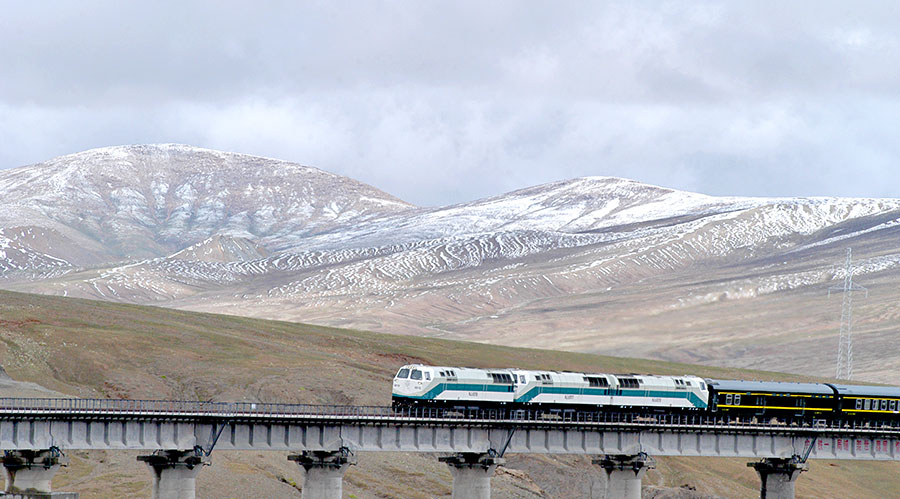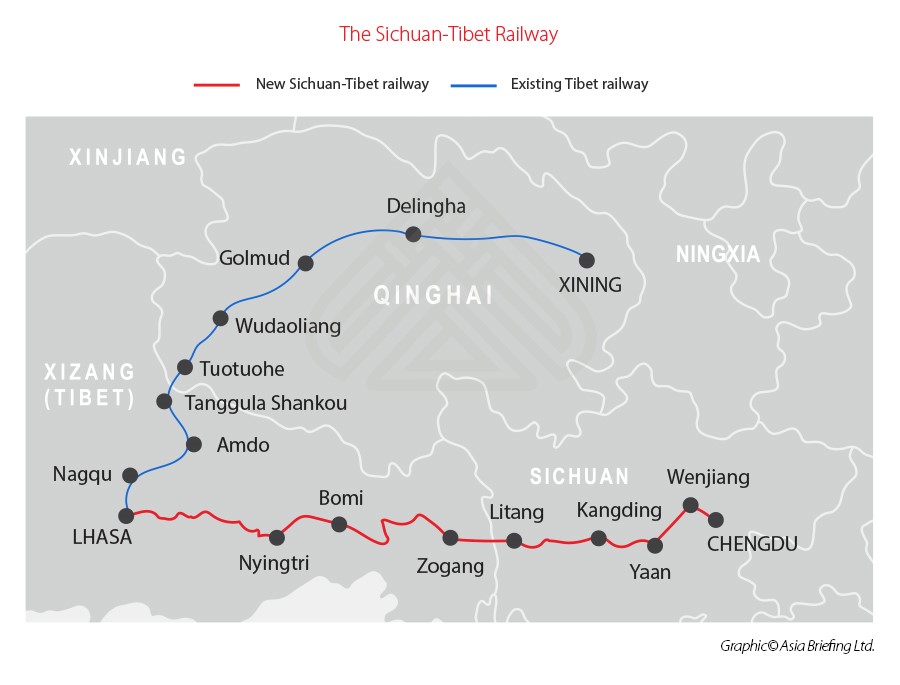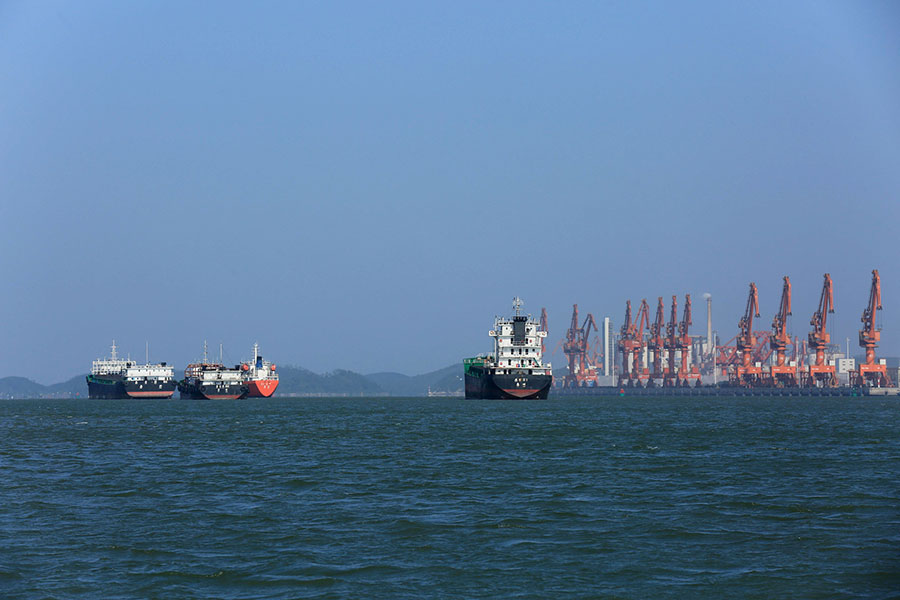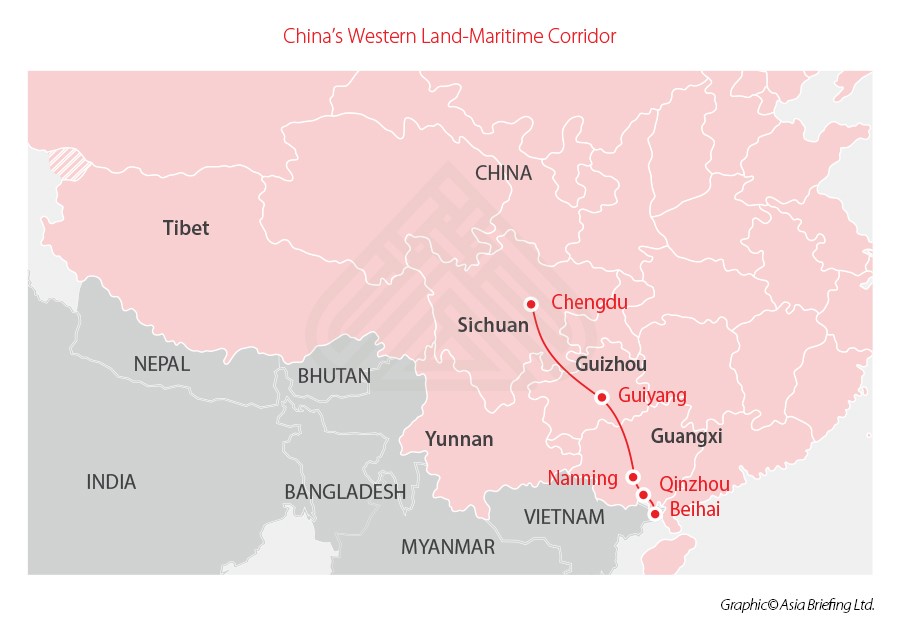China Prioritizes Sichuan-Tibet Rail and Western Land-Maritime Corridor At Two Sessions Meeting

Chongqing, the world’s most populated urban city.
Op/Ed by Chris Devonshire-Ellis
- Schemes provide seaport access for Tibet and Sichuan to ASEAN
- Possible future access to India via Nyingtri
- Guangxi coast will see huge Port development
- Implications also for Hainan Island
- Opens up access to China’s hinterlands of 280 million people
The recent ‘Two Sessions’ meetings in Beijing have been much covered in international media, most concentrating on issues concerning Hong Kong. Our own, rather broader, and inclusive comments can be read from our Beijing Partner Kyle Freeman here.
However, the Two Sessions meeting also revealed that Beijing has prioritized the Tibet-Sichuan rail link, and the Western Land Maritime Corridor as infrastructure developments. Both are part of the Belt & Road Initiative; we highlight these as follows:
Sichuan-Tibet Railway

High-Altitude Tibet Rail
This project is already underway, having opened the first segment from Chengdu to Ya’an in December 2018. This section is 94km (60 miles) in length, is electrified, double tracked, and has a design speed of 200 km per hour.
The second section runs from Ya’an to Nyingtri (also known as Nyingchi) in Tibet and is 1,011 km (628 miles) in length with a design speed of 120–200 km per hour. It traverses a seismically active region with difficult terrain and a fragile ecology. Construction began in November 2020 and is expected to be completed in 2030.
The Nyingtri to Lhasa segment is currently under construction, covers 434 km (270 miles) with a design speed of 160 km per hour (100 mph). Construction began in 2015, with tracklaying completed in December 2020. This section is expected to open on 30 June 2021. Nyingytri is on the border with India (I have previously visited the area by road from Lhasa) and is sited near the confluence of the Lhasa and Bramaputra Rivers. Nyingtri has an airport and is also connected to Lhasa by road. Should attitudes from India change concerning border areas, Nyingtri as a city would boom as a trading hub.

The 1700-km, 250-billion-yuan (US$36.88 billion) rail project when completed between Sichuan’s capital Chengdu and Tibet’s capital Lhasa will travel through eight major ascends and descends, with the cumulative ascents exceeding 16,000 metres. Except for Ya’an, all the major stations of the train service are in Tibet, namely, Kangding (Tibetan: Dartsedo), Lithang, Chamdo, Bangda (Pomda), and Nyingtri. The Bangda station, at 4,300 metres above mean sea level, is the highest. The reference at the Two Sessions meeting to prioritizing the route is expected to result in the entire line being operational in 2028, two years ahead of the original schedule.
Western Land-Maritime Corridor

Qinzhou Port, Guangxi
The Western Land-Maritime Corridor is a related project, extending from Chongqing through to China’s south-western Guangxi Province and access to the South China Sea. Chongqing is linked to Chengdu by intercity high-speed rail, as well as the G76 and G85 expressways over a distance of 340 km. The rail journey takes 75 minutes. When linked to the Chengdu-Lhasa rail system described above, the Western Land-Maritime Corridor effectively provides Tibet and land-locked Sichuan Province with sea-port access at ports on the South China, coast and to markets in ASEAN. The Guangxi Ports will also open up China’s hinterland of some 280 million people, equivalent to 7 California’s, of which about 100 million are to middle class consumer standards yet have until now been difficult to reach.

The Impact On Hainan
Just off the coast of Guangxi is Hainan Island, a province that is being developed as major South China Sea services centre. Hainan does have policies that are different to mainland China: medical tourism for foreigners and mainland Chinese, Hainan will have access to imported drugs and treatments not available in mainland China, together with supporting medical insurance coverage for medical treatments such as anti-cancer programmes.
There is also an enhanced ‘negative list‘ that is wider than that on mainland China. I wrote about Hanan as a great base for China CEO ‘s to be based here.
The New International Land-Sea Trade Corridor
China’s National Development and Reform Commission released the original “General Plan for the New Land and Sea Corridor in the West” in 2019. According to that, the Western regions of China will open a corridor to the South China Sea. By 2035, the container volume of rail-sea intermodal transport will reach 500000 TEUs, while the container throughput of Guangxi’s Beibu Gulf Port and Hainan’s Yangpu Port will reach 10 million and 5 million TEUs respectively. The main concept of the Western Land-Maritime Corridor is to provide stronger transport capacity, a more reasonable hub layout, more convenient multimodal transport, logistics and customs clearance efficiencies while at the same time having the overall logistics costs for servicing the region decline. With the two sessions meeting talking about ‘enhancing’ this project, our view is that completion timeframes will be brought forward by 2-3 years.
Overall, these two projects are component parts of the ‘New International Land-Sea Trade Corridor’ a trade and logistics passage with an operational hub centered on Chongqing. The corridor has already connected to 190 ports in 90 different countries in September 2019 and is among one of many corridors under the Belt and Road Initiative. The corridor is a joint project of the Western China Provinces of Chongqing, Guangxi, Guizhou, Gansu, Qinghai, Xinjiang, Yunnan and Ningxia and Singapore under the government-to-government framework of the China-Singapore (Chongqing) Demonstration Initiative on Strategic Connectivity.
Ultimately it will link the North-West of China’s Xinjiang Province and the incoming rail links from Russia and Kazakhstan through China, continuing south through Laos, Vietnam, Thailand, and Malaysia, terminating in Singapore but with onward sea passage to the Philippines, Indonesia and Australia to the east, and West towards Southeast Asia, the Middle East and Africa.
Some of the soft infrastructure to take advantage of this new route is already being put into place. China has an existing Free Trade Agreement with ASEAN, and the route will further develop ASEAN trade in goods and services in Western China. Russia, meanwhile, along with Kazakhstan and Kyrgyzstan are Asian members of the Eurasian Economic Union. That bloc already has Free Trade Agreements with Singapore and Vietnam and will be keen to develop overland routes with Southeast Asia. China also released a new ‘Encouraged Industries Catalogue‘ for the Western regions last month, while cross-border e-commerce zones have also sprung up across the region.
Related Reading
- Investing in Inland China: Assessing Chongqing’s Industrial Zones
- Hainan’s Negative List Creates Business Opportunities for Foreign Investors
About Us
Silk Road Briefing is written by Dezan Shira & Associates. The firm has 28 offices throughout Asia, and assists foreign investors into the region. For strategic advisory and business intelligence issues please contact the firm at silkroad@dezshira.com or visit www.dezshira.com





